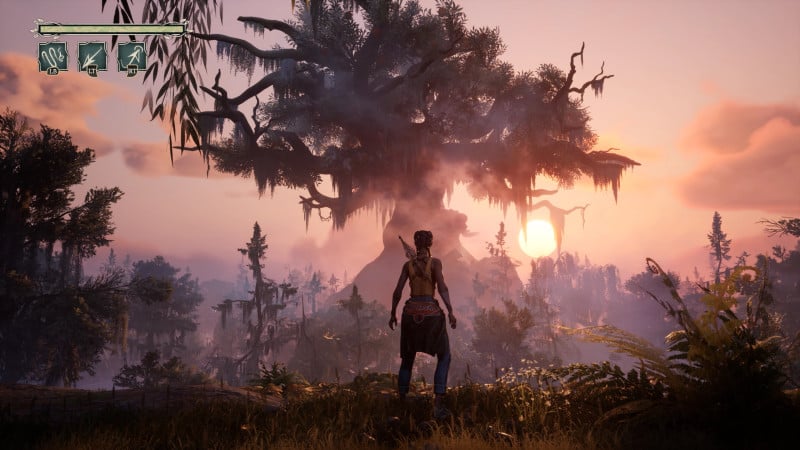Western storytelling loves to use mythology as worldbuilding, but it fixates on Greek, Roman, and Norse myths so often that it’s easy to forget other parts of the world, like the American South, have plenty of folklore as well. South of Midnight, the new action-platformer from Compulsion Games, uses this underrepresented roster of cryptids to great success, telling a heartfelt story centered around a girl and her mother. Its decent combat and platforming are elevated to great heights by stellar visual and musical presentation, resulting in a game I can’t stop smiling about.

Hazel Flood.
South of Midnight stars Hazel Flood, a girl in her late teens trying to track her mom down in the aftermath of a hurricane. Along the way, she discovers she’s a Weaver, a magical person who can use ethereal strands to fight, traverse, and glimpse visions of the past. Unlockable magical abilities are used for combat, traversal, and puzzle-solving, which is efficient from a gameplay perspective and a narrative one; every aspect of Hazel’s life becomes strange and magical, and she has to learn how to handle it. On her journey, she encounters several mythic creatures from Southern folklore and learns the tragic backstories that led to their curses. I always enjoyed these flashbacks, as they flesh out the world in unique ways and seamlessly integrate myths into the main story. Still, the narrative remains grounded, thanks to Hazel’s relationship with her mother, grandmother, and giant catfish companion. Aside from some pacing issues felt most heavily in the game’s slow start and abrupt ending, it’s a touching tale I’ll remember fondly.
Cutscenes and combat are woven together by linear platforming sequences. Hazel can double jump, glide, grapple, and wall-run to traverse the world. You can also head off the beaten path to search for Floofs, the game’s currency for ability upgrades, but I never found the exploration engaging. When you come to a crossroads, you can click the right stick to see the main objective’s direction, so “exploring” boils down to spotting a side path when it appears, briefly heading down it to collect Floofs, and then turning around and getting back on the main path. Still, I was hungry enough for upgrades to search for Floofs whenever possible. Thankfully, a variety of movement techniques keep the experience from feeling too stale. Traversal ultimately feels less like an exciting mechanic in its own right and more like a means to move between beautiful environments, one of the game’s highlights.

Hazel grapples using her Weaver magic.
The best elements of South of Midnight are its art and music. Characters are animated with purposefully skipped frames, creating an aesthetic that falls somewhere between Spider-Man: Into the Spider-Verse and stop-motion animation. Despite these clear artistic inspirations, South of Midnight stands out with beautifully designed characters, monsters, and environments. It’s visually impressive on a technical level as well, earning its spot on modern consoles and PCs. Whether it’s the sunbeams streaming across the dirt at sundown or the haunting visuals of an intense boss battle, I was consistently impressed by South of Midnight’s gorgeous visuals.
The sound design is just as strong, thanks to the inspiration it pulls from the story’s setting. The South has a rich musical history, from bluegrass to jazz to folk, and an appropriately varied playlist of genres scores Hazel’s journey. A tangy banjo, a rowdy trombone, and a dramatic swell of violins are all equally likely to appear in any given level’s soundtrack.
Historically, these songs are also the way stories are passed across generations, and South of Midnight pays homage to this with its boss songs. These original tracks play in the background of climactic battles with lyrics pertaining to that moment in the plot, often from the perspective of one of the characters in the battle itself. “Cinematic” is an adjective used to describe games with grand setpieces or dramatic performances, but these soundtracks are cinematic in a different sense. Action sequences in movies are often underscored by relevant songs playing in the background, so every time I heard the lyrics come in to accompany the boss battle, it felt like I was sitting in a theater, watching popcorn-worthy fight choreography.

Hazel battles the intimidating Two-Toed Tom.
On that note, the combat in South of Midnight is not its strongest aspect, but it grows in complexity towards the end in ways that dramatically improve its quality. Initially, its straightforward third-person action feels derivative. While I didn’t hate it, I never looked forward to it and didn’t find it particularly satisfying. Its most unique element is the Unravel mechanic: When you defeat an enemy, you can pull apart its lingering spirit, slightly healing Hazel and shaving a few seconds off ability cooldowns. These abilities are unlocked through the story, including one that pushes foes, another that pulls them, and a third that afflicts them with a status called Weave, locking them in place and lowering their defenses. They’re useful and should be employed as often as possible, but don’t usually feel like game-changing powers.
This is not the case by the late game. As each ability is upgraded, it unlocks new conditions to afflict Weave and speed up cooldowns, sometimes erasing them entirely. For example, you can instantly reset the Push ability by hitting multiple enemies at once, making a move with a roughly 15-second timer become a part of your regular arsenal. Enhancements like this encourage players to consider positioning and add risk and reward to the powers. Once you add a second dash and exploding Unravels, fights are fast, frantic, and fun as you move quickly to maximize your abilities, refresh their cooldowns, and Unravel foes rapidly enough to get some health back. I wish this complexity was present earlier than the game’s last five hours, but I was mainly glad it reached these heights at all.

Hazel stares down a Rougarou.
Thanks to its vibrant art, music, and storytelling, I had a wonderful time with South of Midnight. Its narrative goes to some surprisingly dark places, yet it still brims with whimsy, making it a fitting adaptation of the mythology with a similar tone. I couldn’t have told you what a Rougarou was a few weeks ago, but thanks to this game, I’ve got a catchy melody of its name that plays on repeat in my head. It’s fitting that, like the stories and songs it seeks to honor, South of Midnight has successfully passed Southern folklore on to a new, wider audience.










Leave a Reply